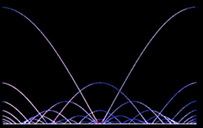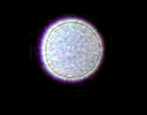Resonance Mandalas of La Maná
In 1984 a large cache of over 300 artifacts was discovered by a small group of gold prospectors led by engineer Dr. Elias Sotomayor in a tunnel 300’ below ground in the jungle-covered mountains of La Maná, Ecuador. Accurate dating of the artifacts is as yet impossible by the latest methods, as the thermoluminescence technique would be unreliable due to years of exposure to sunlight since their discovery. The lithic technology and geometry presented in the artifacts denies placement in known cultural contexts from the region, suggesting that they may predate the known cultures from the region. The symbolism presented in the forms and in inlaid designs and script on the La Maná artifacts most closely relates to those of the Sanskrit culture known from southeast Asian contexts, and has toured Europe in the Unsolved Mysteries Exhibition. The script is consistent with the logographic form of Sanskrit, the mother language from which the Mayan and Egyptian glyphs have descended. The geometric analysis given herein suggests that the La Maná artifacts encode fractal information regarding the resonant properties of calcite mineral, informing the design function of the Orion pyramids of Giza, Egypt - the production of Electrum water.
The La Maná site (0.95°S 79.18°W) is 7,470 miles from Giza; a distance that is exactly 30.0% of the Earth’s circumference. The finds have defied categorization among any known culture from South America, exhibiting iconography consistent with Sanskrit traditions foreign to the region. The place name itself is an ancient one, likely a remnant of the prior Sanskrit inhabitants for whom the word mana meant "mind" or "mental body". The significance of this name may become more clear as the artifacts reveal their encoded psychoacoustic geometry. Most amazing are the representations of the Great Pyramid at Giza, a King Cobra (a snake known to exist only in southeast Asia) and an engraved global map of the present continents of the world and other landmasses now submerged. Advanced technological features are apparent in the stonework, including magnetic zero-point effects and inlaid lines that fluoresce under ultraviolet light. The artifacts defy any simple explanation, revealing that the technological capabilities of ancient man were millennia in advance of that used by industrial man. The group of over 300 objects has remained in Ecuador in the private collection of German Villamar for over a decade since their discovery by Sotomayor, a gift of encoded knowledge from a teacher to student. This analysis of the enigmatic artifacts will focus primarily on the implications of the geometry represented by their forms and inlaid patterns in an attempt to solve the mystery veiled by the cultural diaspora that succeeded the genius of the Sanskrit mother-culture that flourished below the surface of the Earth.
Ultraviolet fluorescence is a well-known property of calcite and other minerals found in natural abundance. The calcite has been mixed as a mortar and inlaid into the lines incised upon the stoneworks’ faces. Visible light is emitted upon exposure to longwave UV (365nm wavelengths) when electrons fall back to their initial or ground states, causing some of the excited energy to be lost as heat, resulting in a shift in the wavelength of the energy to lower energy (longer wavelength) visible light. Many minerals possess this quality, also observed upon exposure to shortwave UV (255nm wavelengths). Various admixtures have apparently been used to specify the light spectra emitted by the differently colored mortars used to achieve the inlays. Manganese is likely among these mineral additives to the calcite mixture, though specific color-producing combinations have not been determined. Calcite can emit a broad range of colors under longwave UV light including white, blue, red, orange, yellow and green, and the ancient artists at La Maná used the entire palette in their geometric designs. This fluorescence effect has been described as quantum scattering, and has also been employed in the creation of brilliant pigments by the ceramicists of the Maya of the Yucatan Peninsula. The clay used by the Maya contained nanoparticles of iron and manganese that, when boiled with indigo produces Maya blue. The metal nanoparticles scatter light in a nonlinear, quantum fashion as the atoms in the metals vibrate near the wavelength of the re-emitted blue light (José-Yacamán et al, Hubbard et al). This resonance amplifies the reflected light just as in the fluorescence artifacts of La Maná, the Maya likely having inherited many nonlinear techniques of the preceding Sanskrit mother culture.
A precisely hewn set of inlaid stone discs was also recovered from the tunnels near La Maná. Their complex strictly geometric design is based on the circle, or mandala in Sanskrit, a sacred symbol used in meditation. The Spiral mandala stone disc is inlaid with a spiral pattern that perhaps references describes an orbital path to the gravitic center, the path inward to the point of stillness. The expanding spiral path is rendered in a blue fluorescent inlay, while the outer circle is a reddish-orange in daylight and brilliant white under UV. The spiral design is today culturally symbolic of inward journey through meditation and used to hypnotic effect in perpetual rotation, inducing the hypnogogic state. This disc exhibits a region of magnetic zero at its center that has been tested consistently, causing any magnet hung like a pendulum over the center of the disc to rotate over the inlaid surface in the very pattern of incised lines. The magnetization of the stone disc was most likely caused by the exposure to strong magnetic fields, like those observed in resonating psychoacoustic architecture as described earlier. The circular stone disc astonishingly presents ancient wisdom concerning the relationship between magnetism and gravity, planetary forces that can be focused.
A pair of palm-sized octagonal stone plates found together may have been placed on each palm during meditation. One octagonal stone is inlaid with 7 concentric circles, and the other with both concentric and offset circles inlaid. The stone with the concentric set contains seven light-colored circles, another prime number reference. This pattern of concentric circles is a mathematical expression of the structure of prime numbers, described later as a unifying design of the cosmos. The concentric rings are also identical to those that are produced by the refraction of light through calcite crystal. One finds this same pattern of concentric rings at the center of the crystallographic image of calcite. Astoundingly, the ancient artists of La Maná precisely represented the refractive symmetry of calcite crystal, the very property that produces the observed effect of UV fluorescence. Indeed, the design itself is a complete visual explanation of the fluorescence phenomena of the inlaid calcite mineral, which is also the main constituent of the limestone from which the Orion Pyramid complex was constructed. Not only the fluorescent effects of the mortar materials used, but indeed the complete forms of the stoneworks were designed to convey the standing wave structure of Magnetic Resonance. The wavelengths of light produced by the calcite inlaid circles organize themselves into the same distinct pattern as the ELF wavelengths of sound resonating through the Orion Pyramids. These mandala represent the resonance of earth, a pattern of refraction observed of all wavelengths of energy.
A central principle underlying the hypothesis of Magnetic Resonance is that the magnetic North pole is the center from which emanate the frequencies of Earth’s hum, presenting an interesting possibility. Perhaps the variation between the designs of the two octagonal discs can be seen as describing the structure of Earth resonance at two different quantum states associated with different locations of the magnetic North pole. The current location of the magnetic North pole fluctuates more than 11 degrees off the geographic N pole, as has been the general case for the last 12,000 years of global warm trends. The preceding Pleistocene glacial age was abruptly ended by a catastrophic event that likely involved the offsetting of the magnetic poles to their current location. The octagonal stone disc with offset multicolored circles may be symbolic of the current misalignment of the magnetic pole and the resulting asymmetry in the standing wave patterns of Earth resonance. The prior high-resonance alignment is presented by the La Maná artists as perfectly concentric circles in the octagonal symmetry of calcite, the seven circles are prime. This octagonal cross was once called the "rose cross" by the Copts, and is referred to by Native American tribes as the four-quartered hoop of the nation, and is a complex structure underlying the meaning behind prime number references encoded in myriad artifacts from La Maná. In their collective presentation of the sacred order of primes, the deeper holistic meaning of these artifacts comes into focus.
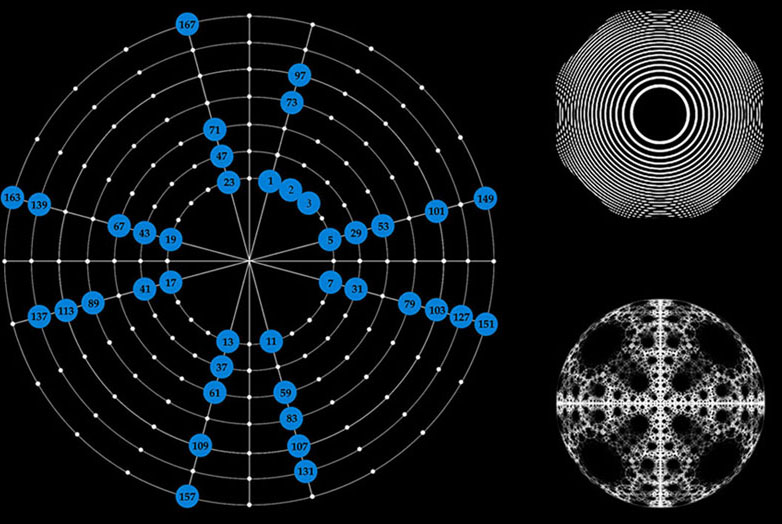
The Archaic Sanskrit script has been documented on a few of the La Maná artifacts, though the complexity of geometric symbols used far exceeds the basic texts, suggesting that their defining global language is the mathematics of prime numbers, the universal language of consciousness. The structure of prime numbers has been of deep interest to pure mathematics. The essential question has remained unanswered: whether or not prime numbers appear randomly in the sequence of whole numbers. While prime numbers generally display a six-cycle of prime pairs there appears to be no repeating pattern, beneath the cyclical order. Geometric fluorescent inlays presented in the La Maná stoneworks repeatedly reference prime numbers 3, 5, 7, 11 and 13.
Prime numbers are defined as numbers that are only divisible by 1 (and by themselves). The organization of prime numbers within the series of whole numbers has been a mystery to modern mathematics until the work of Peter Plichta, a Dusseldorf chemist. In 1997 he put forth his theory of the structure of prime numbers being based on a cycle of 6, a product of the indivisible numbers 1, 2, and 3. While not the first mathematician to recognize the six-cycle of the sequence of primes, his work has extended this understanding to the role of prime numbers in all of the structures underlying the physical universe.
Apart from the numbers 2 and 3, all prime numbers occur in a cycle of 6. 6 n ±1 for n = 1, 2, 3, 4, ....
For combination reasons this cycle produces a series of prime-number twins, [5,7], [11,13], [17,19], 23, ....
although with the number 25 we inevitably obtain the first square of a prime number from the function 6 n ±1
(the next composite number is the product of 5 x 7 = 35) which is not prime. The reason why the number six
plays such an elementary role in the complex of whole numbers is that the numbers 1, 2 and 3 are indivisible.
As a result, the complete number 6 must be surrounded by the expression: 6 - 1 = 5 and 6 + 1 = 7 and thus
the first pair of prime numbers.
Plichta’s search for the significance of prime numbers extends to the essential structures of nuclear chemistry and biochemistry, specifically that of atoms and the periodic table of elements, as well as the amino acids and the DNA helix. The six-cycle structure of prime numbers can be visualized as an octagonally symmetrical cross, with seven concentric circles divided into 24 radial points. Being a universal constant "the Prime Number Cross is not a human invention. It is in fact a model of the construction plan with which infinity was made finite in the structure of the atoms." This same model has also been derived by the quantum mechanical algorithms of theoretical physicist Arkadiusz Jadczyk in a more complex rendering, the Octagonal Quantum Iterated Function (QIF). The Prime Number Cross and the Octagonal QIF are synchronous patterns reflecting the structure of resonance inherent to atomic, molecular, planetary and galactic structures.
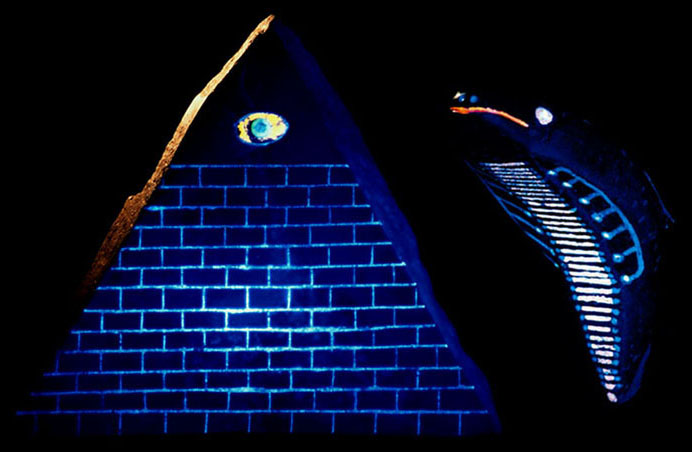
The most intriguing artifact of the group is a representation of a pyramid (above) with 13 horizontal divisions or steps, 3 sides on the inlaid triangular face and 1 eye symbol. The single engraved and inlaid florescent eye is a Sanskrit spiritual symbolism for psychic vision: the third-eye. As there are no known true pyramids in the Americas, only a multitude of stepped pyramids, this must be considered a representation of the Great Pyramid at Giza thousands of miles away. Interestingly, this Ecuadorian artifact records the third-eye symbol of the original façade whose casing stones are now absent. The reverse side of the triangular artifact bears a gold-plated inscription of the Orion’s belt constellation and a series of Archaic Sanskrit glyphs, as yet uninterpreted.
The Sanskrit word "naga" means serpent while kundalini means "snake", and is used as a spiritual metaphor for a coiled cord of energy residing in the human body, symbolically embodied in the hooded cobra native to sub-Himalayan Asia. Kundalini creative energy can be stimulated to elevate consciousness through the natural chakra system (Sanskrit for "wheel"), an alignment of seven rotating vibratory centers of the body. Chakra energetic levels correspond to light and sound spectra, each with a distinct frequency and color, the lowest frequency basal or root chakra being red, and continuing in ascending order through orange, yellow, green, blue, and indigo to the violet crown chakra, highest in frequency. This string of energy wheels can be thought of as the foci through which human consciousness escalates. The lingam is a phallic instrument used anally during meditation to release the coils of the kundalini serpent into upward movement along the spinal cord through all 7 chakras to blossom at the crown. This stimulation of the energetic flow is understood to promote expanded awareness, having powerful effects on consciousness. These Sanskrit concepts are holistically encapsulated in the inlaid patterns of a La Maná stone, the Kundalini Cobra lingam (above), geometrically describing this movement of energy from the dotted center on the tip of the phallus along the ventral stripes through the 7 chakras depicted on either side of the cobra’s hood. Prime numbers are depicted in fluorescent inlays, 1 dot at the head of the phallus, 2 dots for the eyes and 2 for the nostrils and 7 connected dots at each side of the cobra’s hood. The number 33, a product of primes 3 and 11, is also presented in the pink and blue horizontal inlaid bands on the cobra’s ventral side. The number 7 is also encoded by the nostrils and mouth together forming the Sanskrit and Mayan numeral.
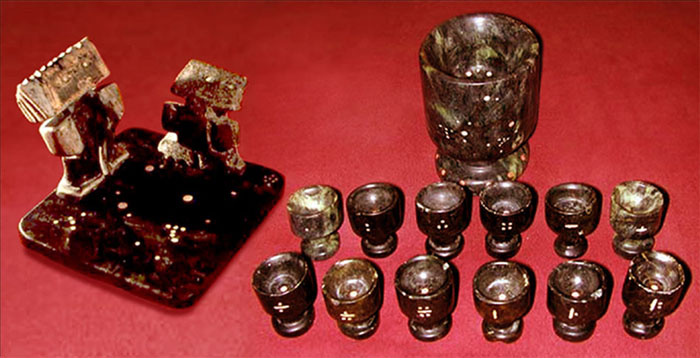
A pair of constellation maps was also precisely rendered in stone long ago to be found in tunnels below La Maná. Two stone figurines were found on a stone plate inlaid with dots forming several constellations that glow under UV light like stars in the night sky. The constellations presented on the base do not exactly conform to current observations, suggesting their great antiquity, yet can still be easily identified a representation of the area of the night sky around Orion, the hunter. Also depicted are the lone star Aldebaran, the Pleiades or Seven Sisters, and Castor and Pollux of the Gemini twins and Procion. The base is a symbolic terrestrial reflection of the night sky to which the two standing figures are transfixed. The figures are clad in bulky suits, robot-like, leaning back to gaze at the stars above, their wide inlaid oval eyes and outfits fluorescing with the dotted constellations under UV rays. These two enigmatic figures simply gaze silently into the same region of Orion’s belt repeatedly mirrored in psychoacoustic architecture.
A set of 13 stone cups with UV florescent inlays was also discovered, another prime number reference. Made from jade, the cups’ perfected geometry suggest advanced lathe techniques were used to rotate the stone while being cut. One of the cups is oversized and inlaid with a pattern of dots representing the same group of constellations represented on the Stargazers’ map. The large stone cup is also inlaid with twelve florescent blue dots around its stem, another larger set of twelve orange dots around its base and around the bottom of the interior of the cup. Each of the twelve smaller cups bears an inlaid dot inside the cup and a numeral on the outside, and the total liquid contents of the smaller cups exactly fills the volume of the single larger vessel. The small cups numeration of one to twelve is associated with the zodiac and calendar calculations of the precessional cycles of Earth. The La Maná numerals resemble those of the Mayan culture whose complex astronomical calculations are preserved in their 20 sacred calendars.

It has long been suspected that the profound astronomical knowledge and accuracy of observation of the Maya, Sumer and Egypt are the inheritance left by a prior advanced civilization, just as their numerals and logographic script. The Mayan culture speaks of its ancestors as an advanced civilization of white-skinned people, a complexion that may have resulted from subterranean living, and the realm in which the technically complex La Maná artifacts were discovered. The beginning of the Mayan cosmic Baktun calendar predates the Mayan culture itself by millennia, a fact that suggests the continuity of the knowledge of cosmic cycles from a more ancient advanced source. The complex sacred teachings have been passed on meticulously by Time Keepers, medicine men like Gerardo Barrios Kaanek who began his spiritual journey at the age of 13 with a Maya master of knowledge, Ajq’iij. Kaanek relates that we are living in the times of the prophecies of the Ox Lahuj Baktun. This, the cosmic calendar, spans 5,200 years and it will end on December 21, 2012, of the Gregorian calendar.
The closing of this calendar cycle is prophesied to be a period of great destruction and renewal for humanity, a cataclysmic shift involving the whole solar system. The planetary calendar is called the Ha’ab. There are four prophetic calendars of which one has a time lapse of 9 times 52 years, known as Belajeb Bolamtiku or ’the nine periods of darkness’. This calendar relates to the foreseen darkness brought by the Spaniards in the form of disease, guns and Catholicism. Its duration is 468 years having begun on the exact day and hour Hernando Cortez arrived in Veracruz, Mexico. The Belajeb Bolamtiku cycle has already elapsed, and has been followed by a nine-year cycle of gestation that ended in the Gregorian calendar year 2001. The most important of the Mayan calendars are the Tzolk’in and the Tzolk’ij. The Tzolk’in is for the observation of time, and of the various energies that interrelate with the human being, having 260-day cycles matching the human gestation cycle. A 9-month period of the Gregorian calendar, the Tzolk’in cycle is nearly 5/7 of the Solar Year (260 = 5 x 52 = 13 x 20 and 364 = 7 x 52 = 13 x 28). Fibonacci numbers and relationships have been found to underlie the interaction of Tzolk’in cycles with the other calendars, being based on the numbers 5, 8, 13, and (the sum of the first six Fibonacci numbers) 20. The observance of interpenetrating temporal rhythms by the Maya is linked with their conception of k’ulthanlilni and chacla, corresponding directly to the Sanskrit kundalini energy and chakra centers. Modernity’s shallow linear conception of time is contrasted sharply by the Mayan conception of cyclical time and the primacy of the circle.
Indigenous wisdom widely echoes this penetrating truth, as in the words of Oglala Sioux Black Elk, b. 1863:
You have noticed that everything an Indian does is in a circle, and that is because the Power of the World
always works in circles, and everything tries to be round. In the old days when we were a strong and happy
people, all our power came to us from the sacred hoop of the nation, and so long as the hoop was unbroken,
the people flourished. The flowering tree was the living center of the hoop, and the circle of the four quarters
nourished it... Everything the Power of the World does is done in a circle.
The Hopi of the American southwest referred to their sacred landscape as ’the four corners,’ while the Andean Inca occupied Tawantinsuyu, ’land of the four quarters’. These potent descriptions of the Prime Cross structure is also very accurately described by several other artifacts found in the chambers below La Maná, especially a set of finely polished stone discs inlaid with circular designs that also describe the sacred hoop of the nation, both in its ’unbroken’ state and in its current ’broken’ state of misalignment.
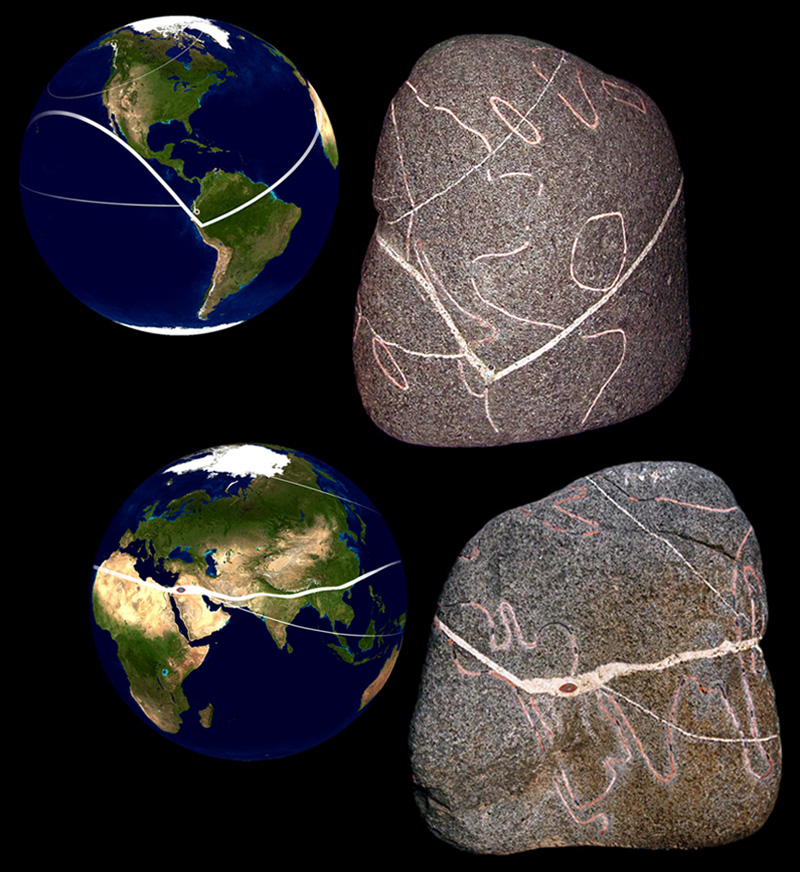
The largest of the artifacts found at La Maná is a torso-sized engraved granite boulder with mortar-filled engraved lines and inset polished stones. The engraved contours are both shockingly familiar and strange, representing the continents of the world in what must be the oldest map known to humanity, a global rendering from the Pleistocene. The stone map’s incised and mortar-filled lines depict the ancient coastlines in pink and another set of straight-line and curving paths in white. Anyone familiar with the shape of the modern continents of the globe can recognize a strong likeness in the artifact’s complex pattern of pink lines. It has thus been named the World Map stone. The continents are quite unmistakable, one side clearly depicting Italy, Greece, the Dead Sea, the Persian Gulf and India. The coastal region of southeast Asia is depicted rather differently than in modern maps, revealing a now-submerged landmass in an area that has been referred to by R. Schoch as Sundaland.
The other side of the stone map reveals the Americas in a somewhat different form, lacking the Caribbean Islands and Florida peninsula, yet representing large landmasses now submerged in the Atlantic and Pacific. In the middle of the north Atlantic lies a small continent that closely conforms to the Greek philosopher Plato’s description of Atlantis, in the dialogues Timaeus and Critias dating from 2,400bp. In the Pacific is depicted a very large island just below the equator, perhaps the size of present-day Madagascar. There is also represented a landmass extending south from what is modern Japan, long since submerged, whose existence has already been proposed by M. Kimura, whose marine archaeological dives in Okinawa and at the Yonaguni monument have informed his hypothesis that the ancient civilization of Mu once inhabited this lost land. These significant differences suggest the great antiquity of the map, as major catastrophic subduction events and sea-level rise must have occurred since the creation of the stonework, placing it perhaps over 12,000 years old.
Continue to The La Maná Pyramids
From the book Phi
Copyright 2006-2015 Alexander Putney
